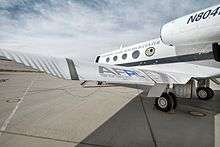Adaptive compliant trailing edge

Adaptive Compliant Trailing Edge (ACTE) is a research project on shape-changing flaps for aircraft wings, intended to reduce the aircraft's fuel costs and reduce noise during take-off and landing. It is a join effort by NASA and the U.S Air Force Research Laboratory [1] and first airborne tests have been conducted in late 2014.
ACTE flaps close the gaps present in conventional flaps using flexible material, generating a continuous bendable surface. As of 2015 enhanced hinged wing flaps (which fold out from under the wing's trailing edge and are used on most jets) are studied. A Gulfstream III business aircraft of the AFRL has been equipped with flaps from FlexSys Inc. and is performing airborne flight tests since 7 November 2014.[2][3] FlexSys Inc., a company founded by Prof. Kota in 2000, is dedicated to develop the concept of a flexible aircraft wing and received US$40 million in financial assistance from the Air Force's small business innovation research program. According to FlexSys the technology helps in fuel savings of 4% to 12% [4] and noise reduction during takeoff and landing by up to 40%.[5]
See also
References
- ↑ "Adaptive Compliant Trailing Edge Flight Experiment". NASA. 10 March 2014. Retrieved 29 January 2015.
- ↑ "NASA Tests Revolutionary Shape Changing Aircraft Flap for the First Time". NASA. 7 November 2014. Retrieved 8 December 2014.
- ↑ "NASA eyes revolutionary aircraft wing technology". Fox News. 10 November 2014. Retrieved 8 December 2014.
- ↑ "FlexSys's wing flaps promise to save fuel". Retrieved 29 January 2015.
- ↑ "Kota's FlexFoil Technology Gains Recognition". Retrieved 14 December 2014.